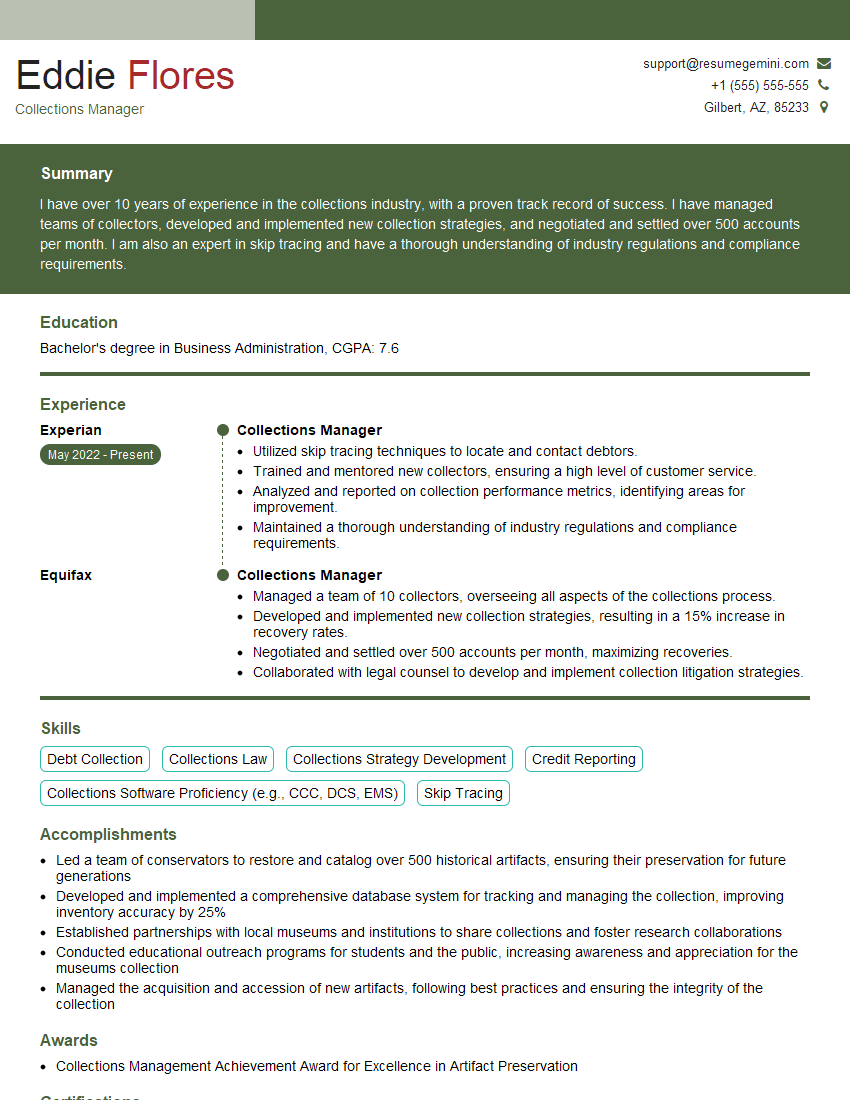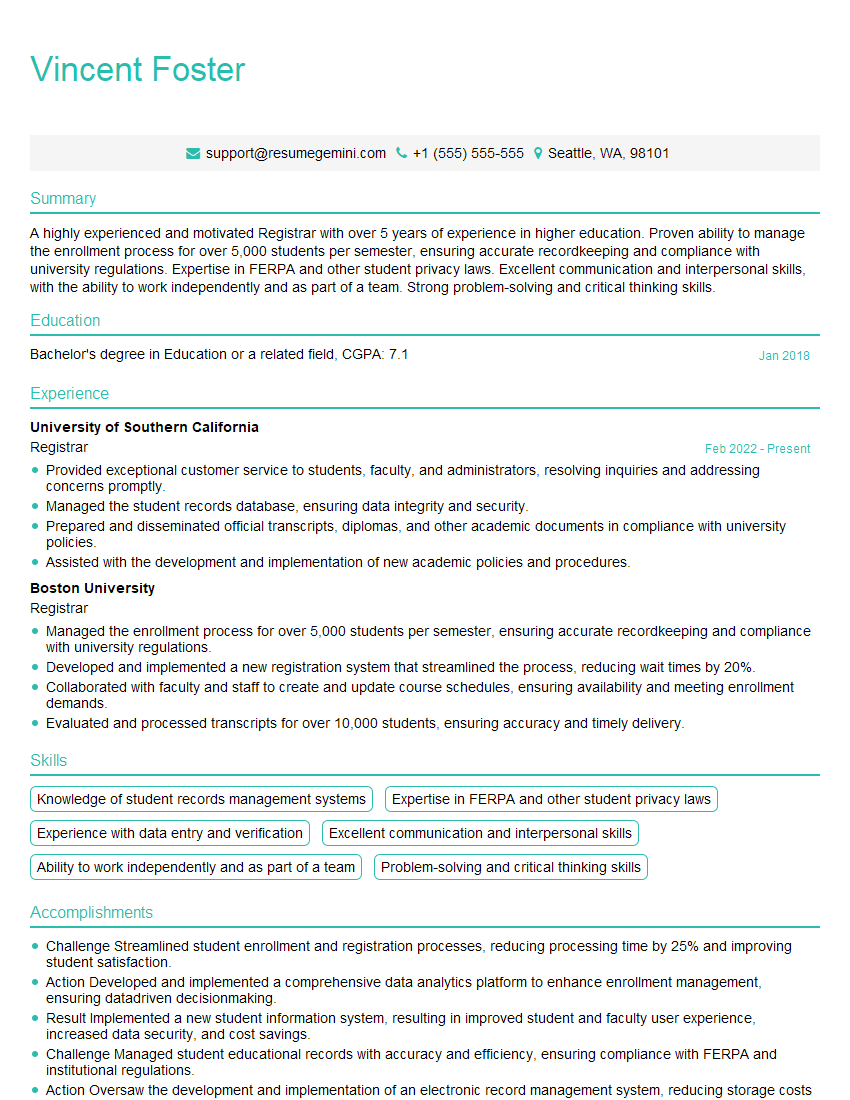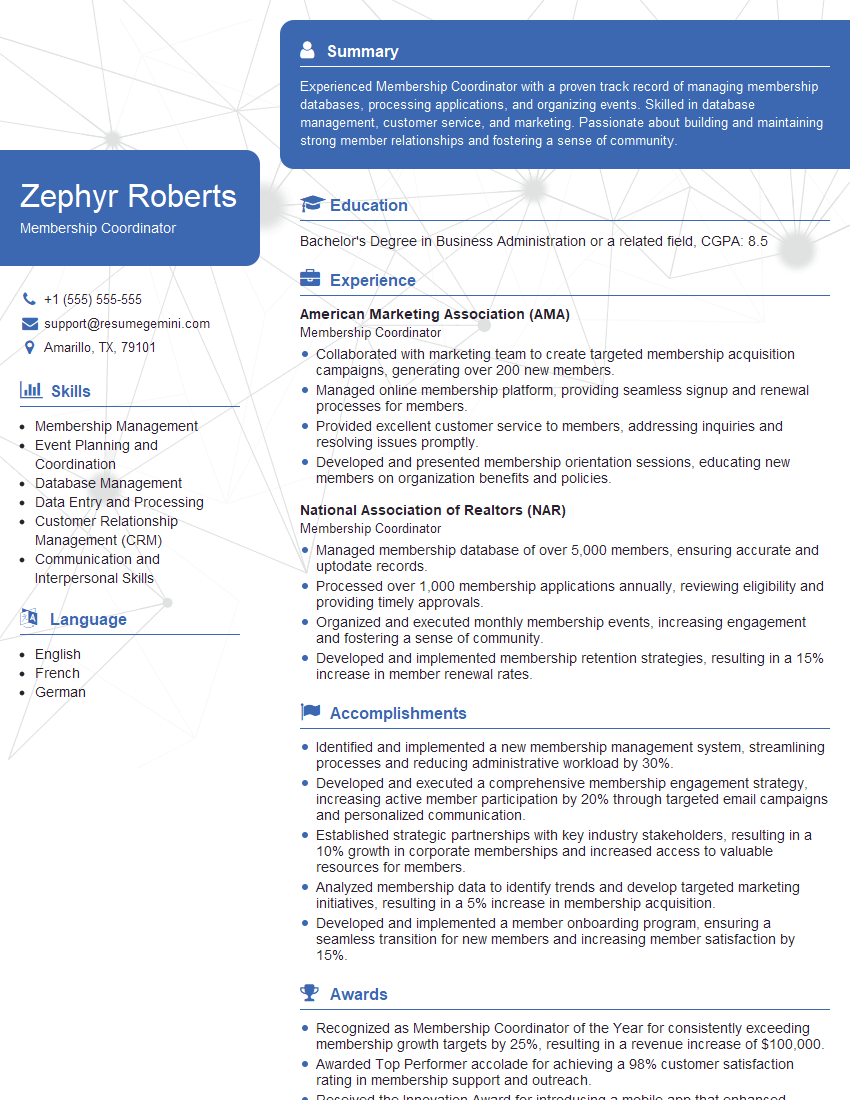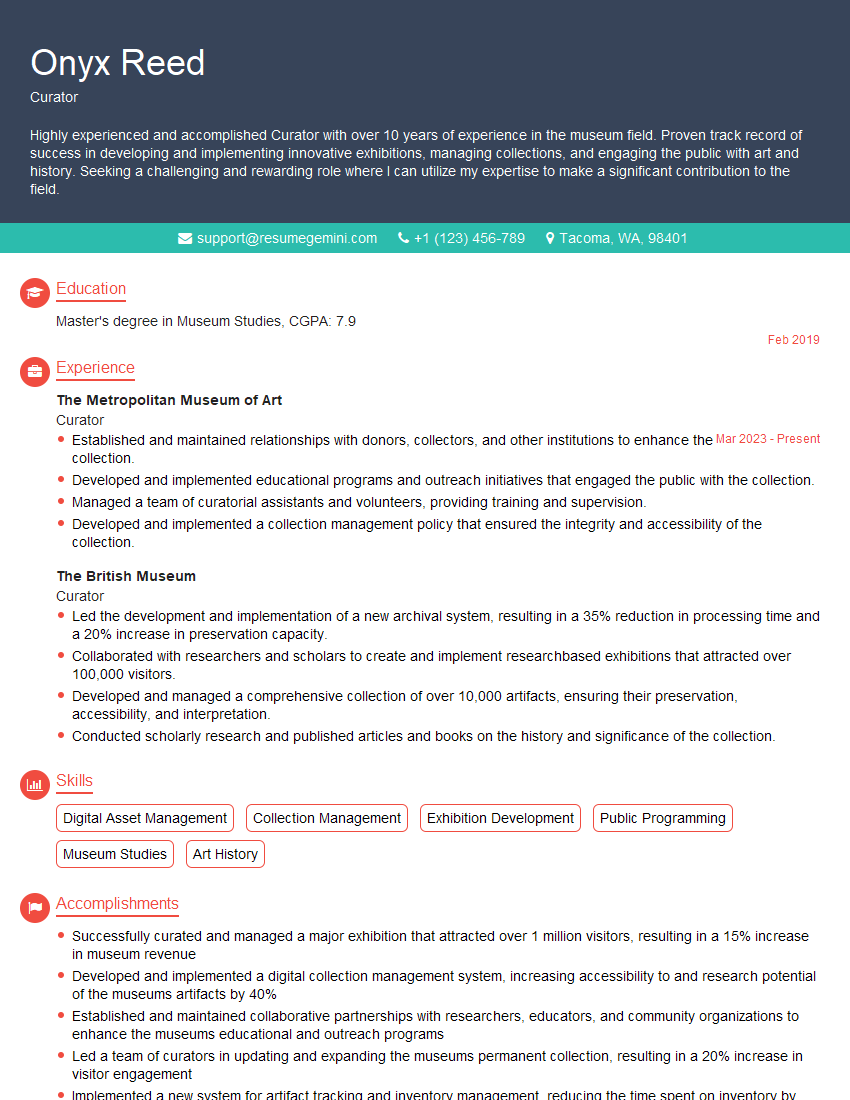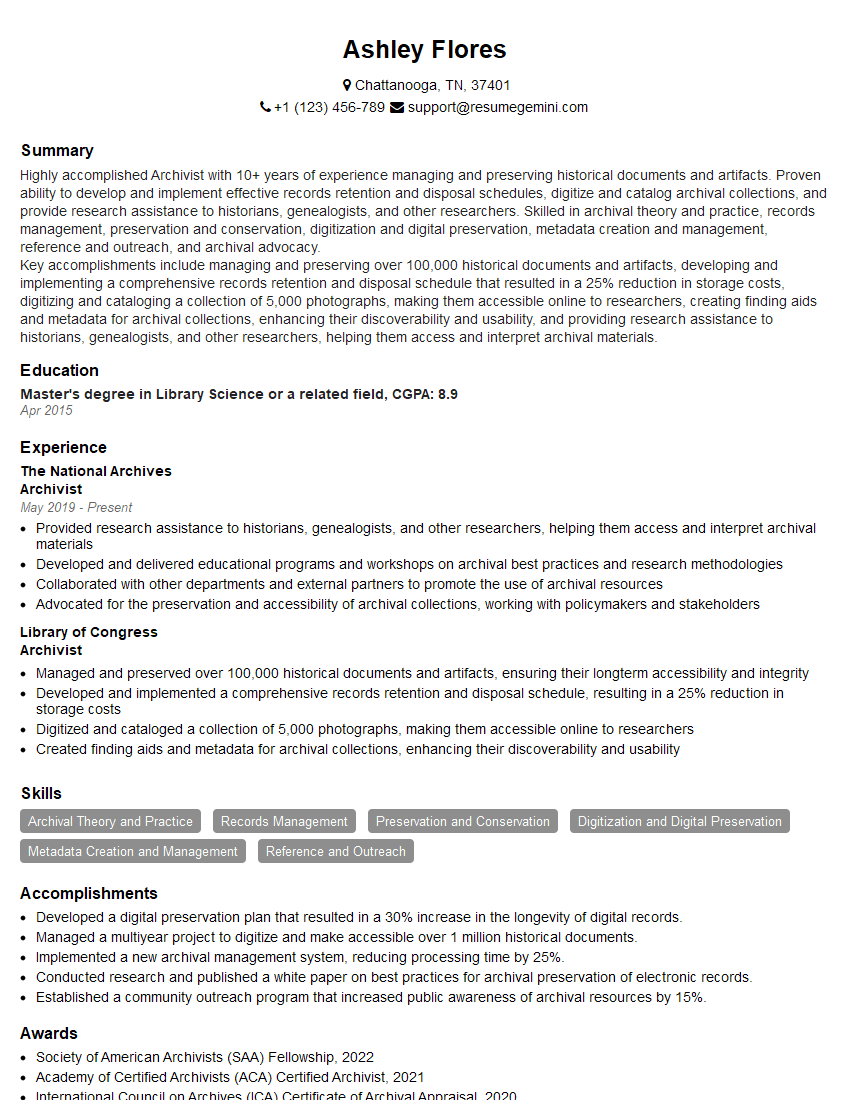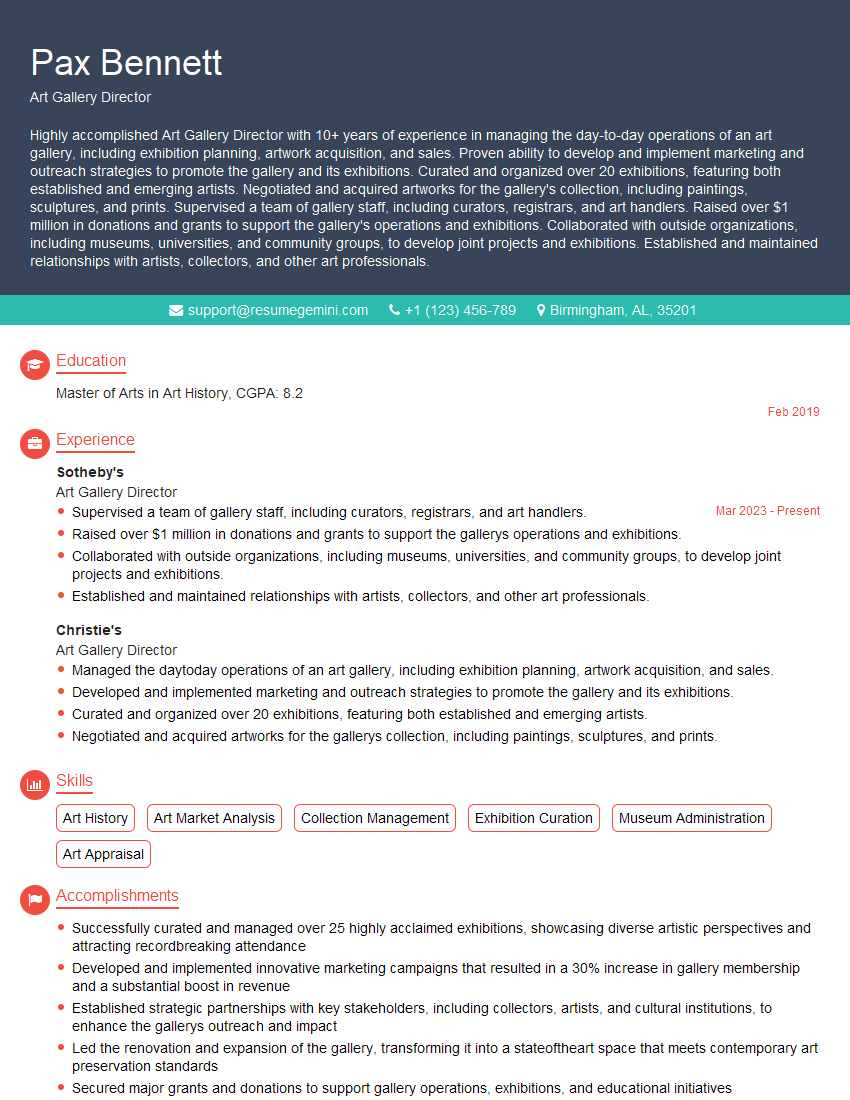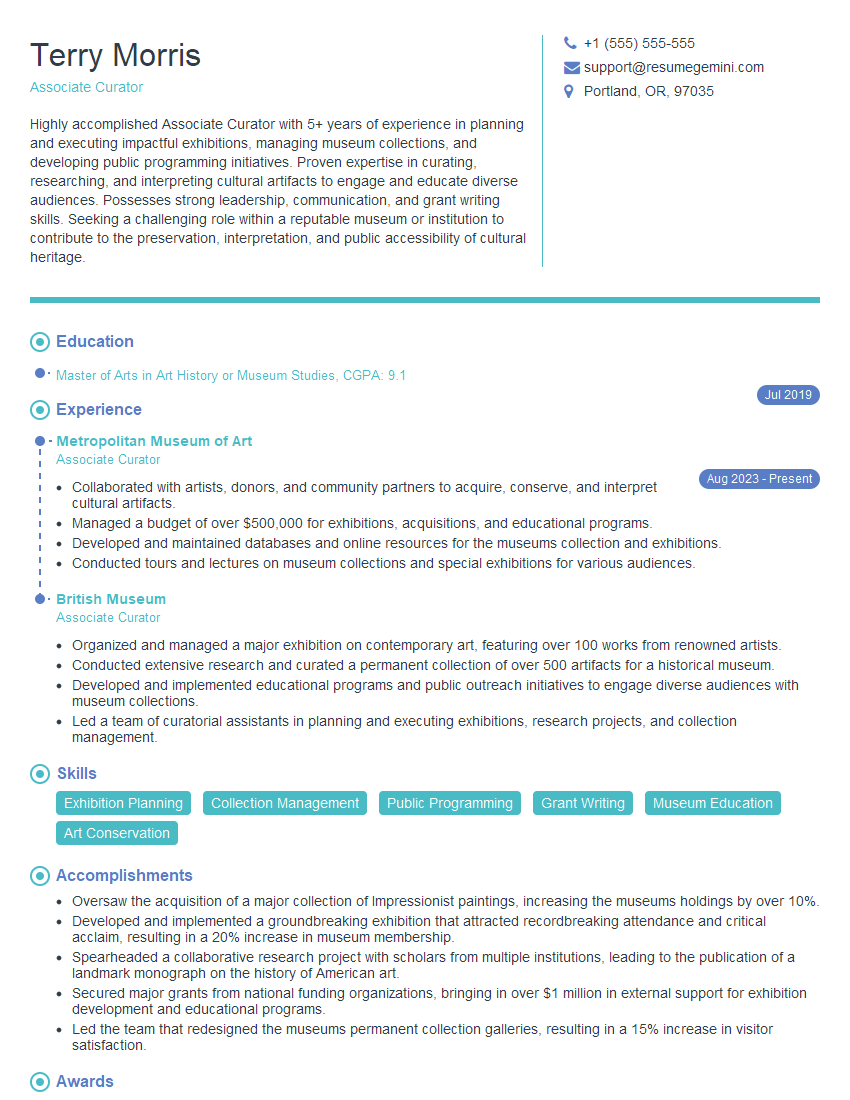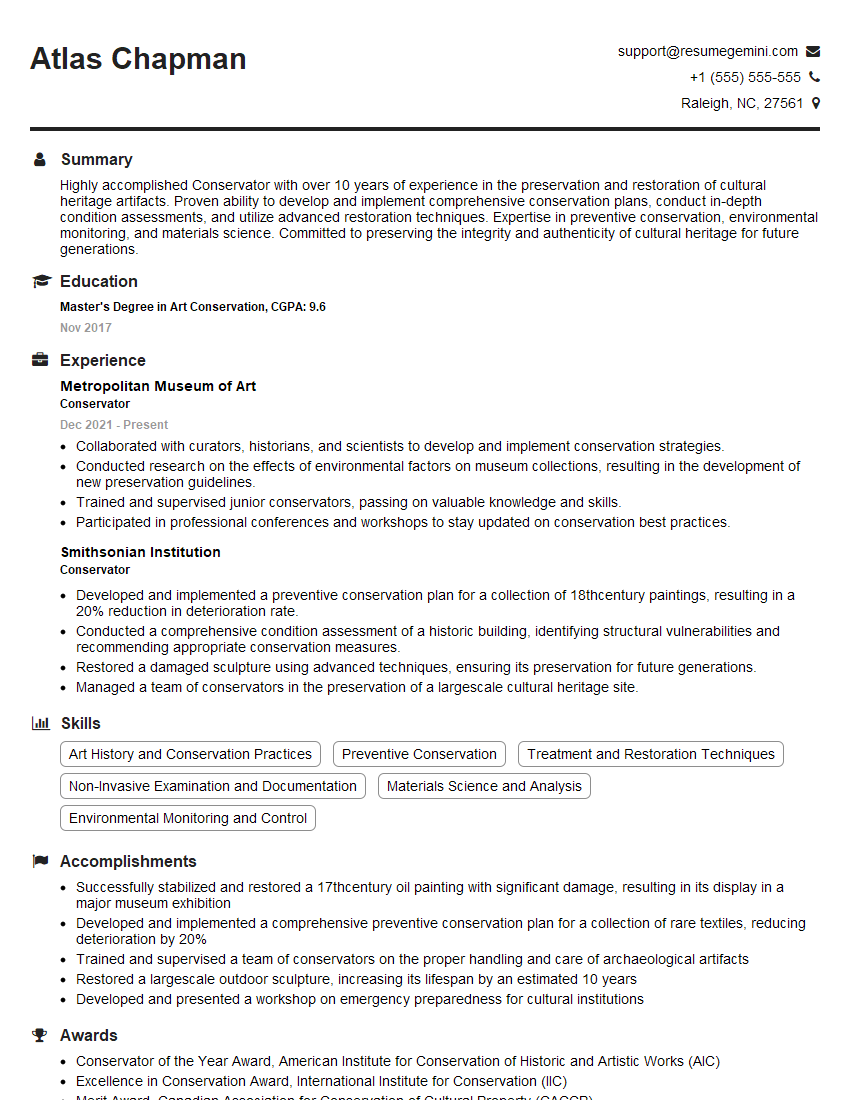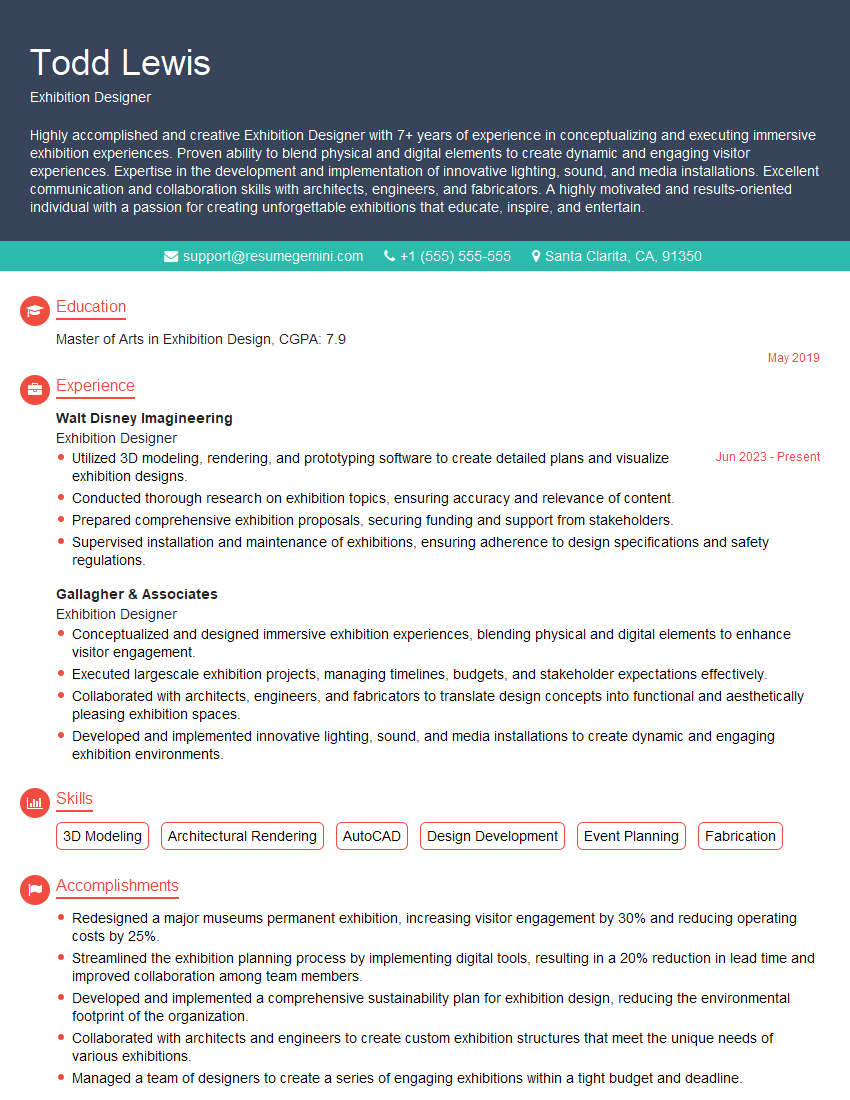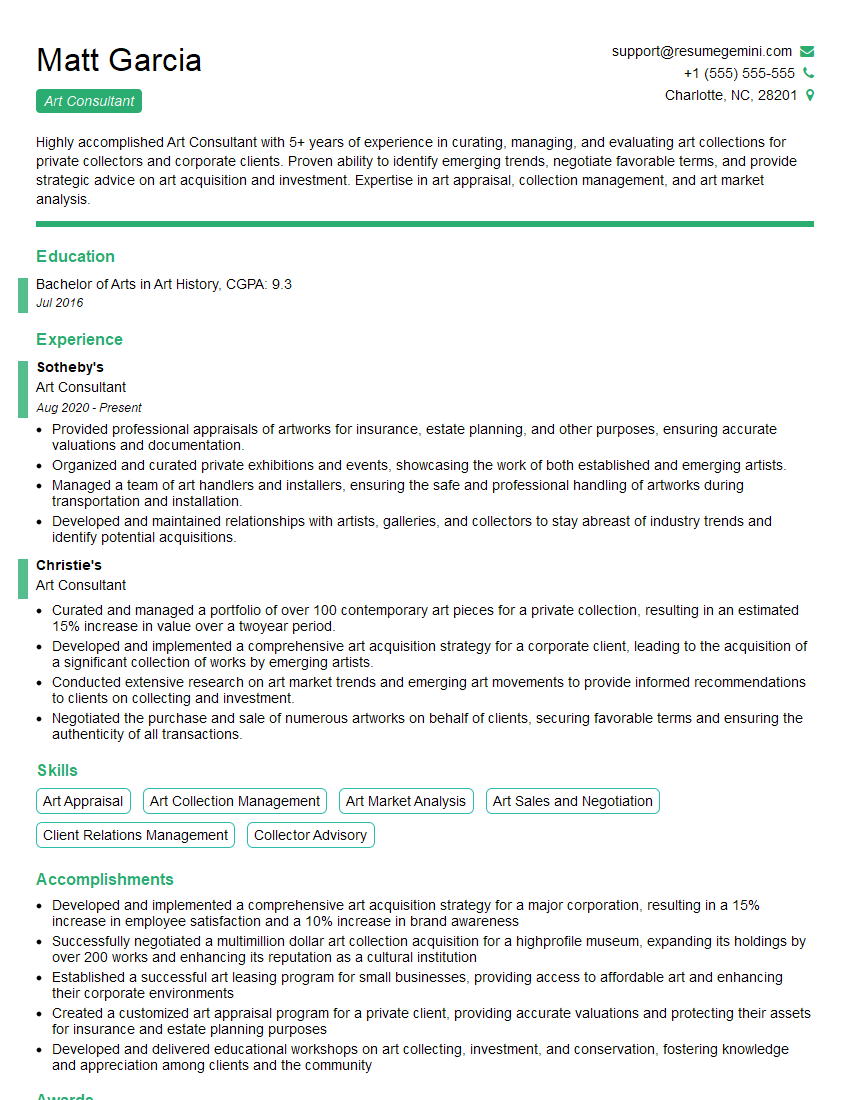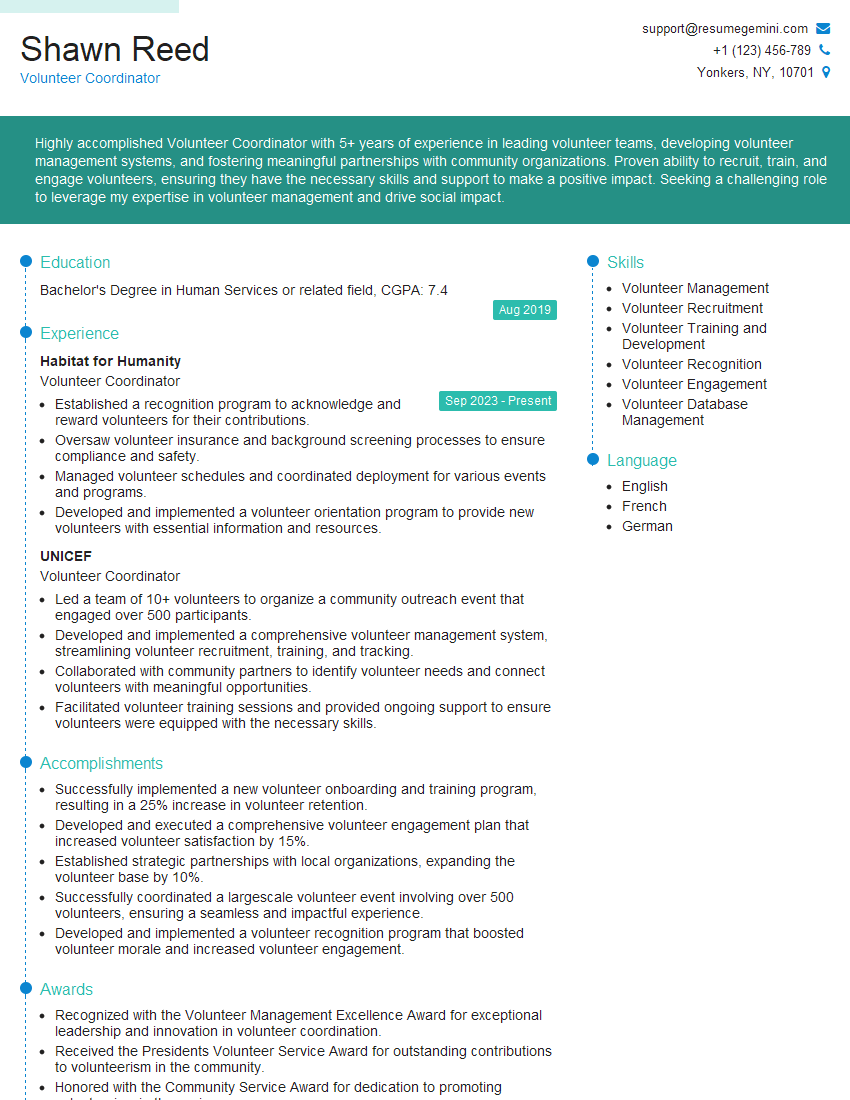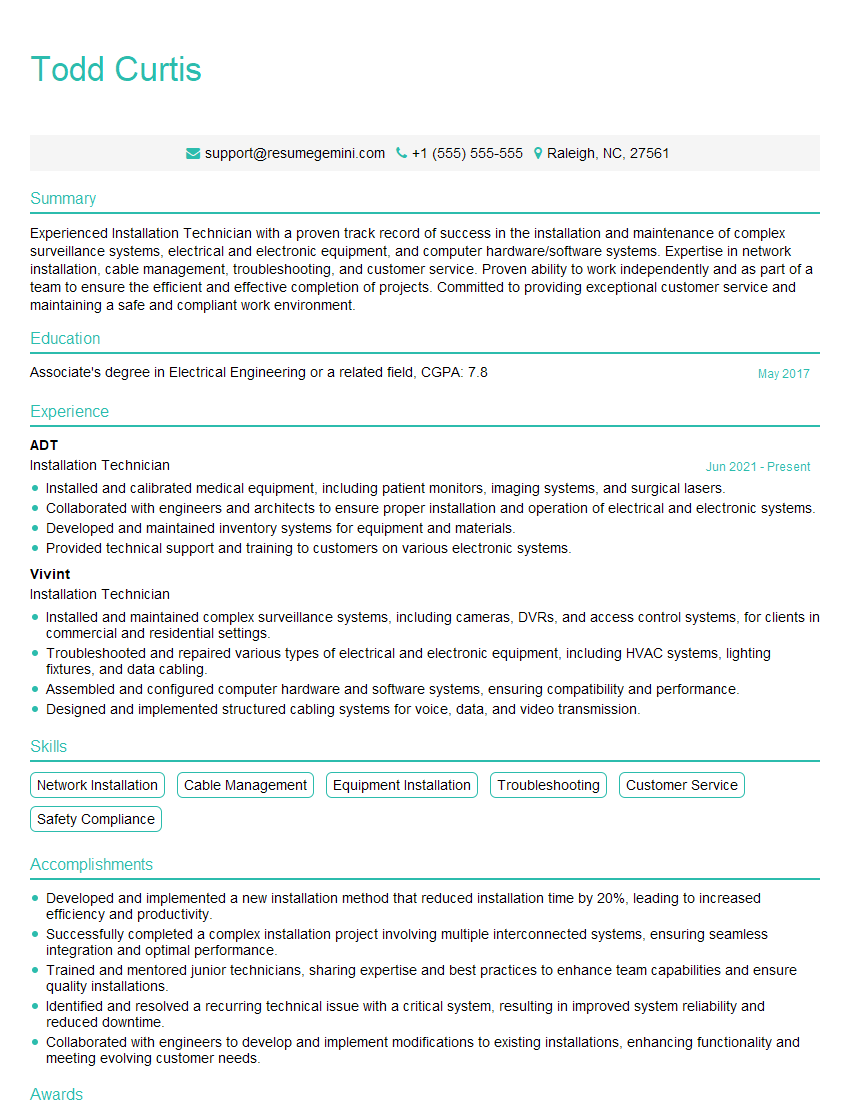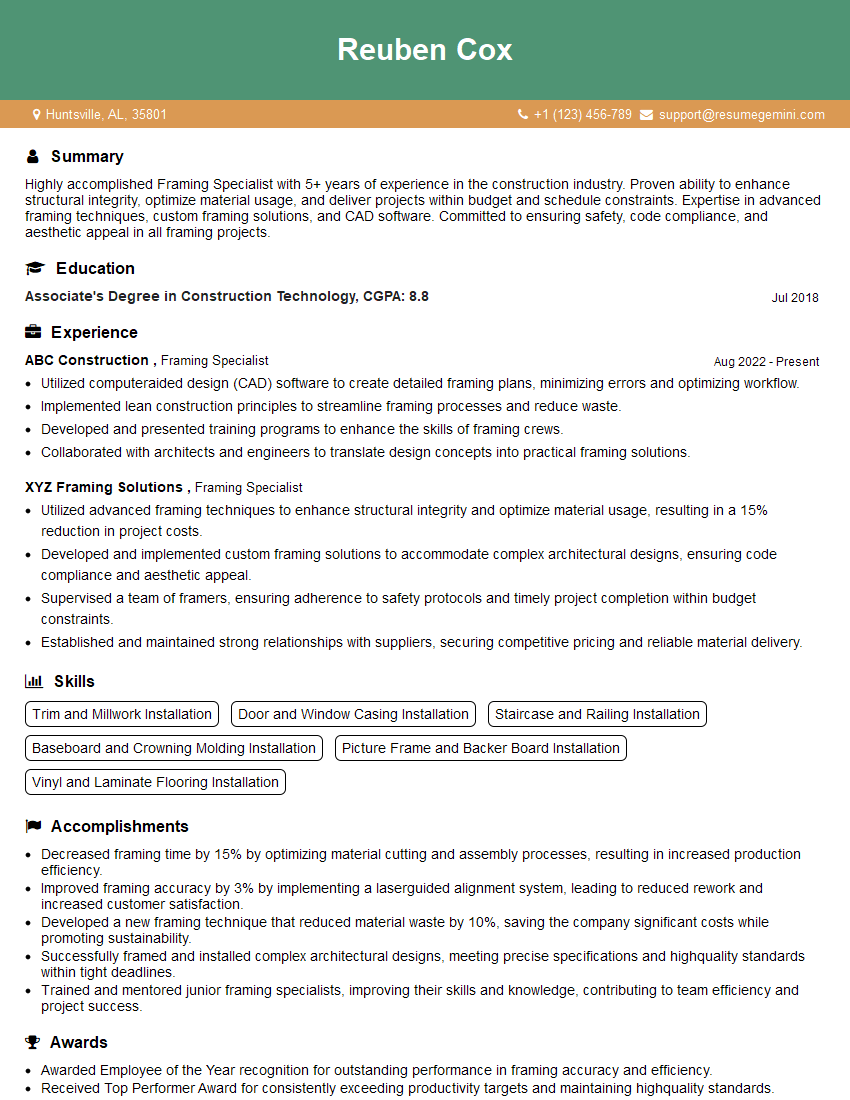The thought of an interview can be nerve-wracking, but the right preparation can make all the difference. Explore this comprehensive guide to Art Gallery Management interview questions and gain the confidence you need to showcase your abilities and secure the role.
Questions Asked in Art Gallery Management Interview
Q 1. Describe your experience managing budgets within an art gallery setting.
Managing an art gallery budget requires a meticulous approach, balancing artistic vision with financial realities. It’s not just about tracking expenses; it’s about strategic allocation to maximize impact. My experience involves creating and adhering to annual budgets encompassing operational costs (rent, utilities, staffing), exhibition costs (artist fees, shipping, framing, marketing materials), and contingency funds for unexpected repairs or opportunities. I use budgeting software to track income from sales, donations, grants, and events, ensuring transparency and accountability. For example, at my previous gallery, we successfully secured a grant for a specific exhibition, which allowed us to allocate more of our operational budget to artist development programs. This strategic approach ensured both financial stability and a vibrant artistic community.
I regularly review financial reports, comparing projected figures against actual spending. This allows for proactive adjustments, preventing overspending and identifying areas needing optimization. For instance, identifying an unexpectedly high cost in shipping led me to negotiate better rates with a different freight forwarder, saving the gallery thousands of dollars annually.
Q 2. Explain your process for selecting artworks for an exhibition.
Selecting artworks for an exhibition is a crucial process demanding artistic sensitivity, market awareness, and curatorial vision. It starts with a clear thematic concept or narrative for the exhibition. Then, I research artists whose work aligns with this theme, considering their artistic merit, market value, and exhibition history. I review portfolios, visit artist studios if possible, and engage in thoughtful conversations to understand the artist’s creative process and intentions. The final selection balances aesthetic cohesion with diversity of styles and perspectives.
For example, for a recent exhibition on urban landscapes, I curated a show featuring both established and emerging artists, selecting pieces that explored the theme in diverse media, from photography and painting to sculpture and installation. The selection process involved careful consideration of the physical space of the gallery, ensuring harmonious placement and visual flow.
Q 3. How do you handle difficult clients or artists?
Handling difficult clients or artists requires diplomacy, empathy, and a strong understanding of professional boundaries. Open communication is key; I strive to address concerns proactively and empathetically, listening carefully to their perspectives and responding with clear, respectful explanations. A collaborative approach, where we work together to find mutually acceptable solutions, is often most effective. Documentation is crucial: maintaining detailed records of all communications, agreements, and transactions helps resolve conflicts fairly and efficiently.
One example involved an artist unhappy with the placement of their artwork. Instead of dismissing their concerns, I engaged in a discussion, explaining my curatorial choices and offering alternative options. Ultimately, we found a mutually agreeable compromise, leading to a positive outcome.
Q 4. What strategies do you use to market and promote gallery exhibitions?
Marketing and promoting gallery exhibitions requires a multi-faceted approach combining online and offline strategies. We utilize social media platforms (Instagram, Facebook, etc.) to build online presence, sharing high-quality images and videos of the artwork and engaging with followers. We also send out targeted email newsletters to subscribers, informing them of upcoming exhibitions and events. Press releases are sent to local media outlets to garner publicity, and collaborations with other businesses and organizations are also explored to reach wider audiences. Offline strategies can include flyers, posters in high-traffic areas, collaborations with local businesses, and participation in community events.
For instance, to promote an upcoming exhibition of contemporary photography, we collaborated with a local coffee shop, hosting a small preview exhibition and offering complimentary coffee to attendees. This created a buzz within the community and generated interest in the main exhibition.
Q 5. Describe your experience with art handling and installation.
Art handling and installation require precision, care, and specialized knowledge. Experience includes assessing the physical condition of artworks, selecting appropriate handling techniques and materials (gloves, acid-free tissue paper, etc.), and arranging safe transportation. Installation involves meticulous planning, working with artists and installers to ensure accurate placement, lighting, and presentation. I understand the importance of environmental control (temperature and humidity) to preserve the artwork’s integrity. Proper documentation, including photographic records of before and after installation, is essential for insurance and archival purposes.
For instance, handling a large, delicate sculpture required developing a detailed plan for transportation and installation, utilizing specialized equipment and employing techniques to ensure it remained undamaged during the process.
Q 6. How do you manage inventory and track artwork provenance?
Inventory management and provenance tracking are crucial for maintaining accountability and transparency. I employ a database system to record detailed information about each artwork, including artist name, title, medium, dimensions, acquisition date, provenance (history of ownership), and current location. This system allows efficient searching and reporting, greatly assisting with sales, loans, and insurance claims. Provenance documentation is meticulously maintained, as it is legally and ethically important. Regular audits of the inventory are conducted to prevent losses and ensure accurate records.
For example, we utilized a specialized database that automatically generated reports of artwork locations and insured values, streamlining inventory management and reducing the risk of errors.
Q 7. What methods do you use to engage with the local art community?
Engaging with the local art community is essential for building relationships and fostering a vibrant artistic ecosystem. I actively participate in local art events, such as gallery openings, artist talks, and workshops. I build relationships with other galleries, artists, and collectors through networking and collaborative projects. We host artist talks and workshops at our gallery, providing platforms for artists to share their work and connect with the community. Supporting local artist initiatives, sponsoring art programs, and participating in community outreach programs demonstrates commitment to the local scene.
For instance, we partnered with a local university’s art department to host a student exhibition, providing a platform for emerging artists and strengthening our ties with the academic community.
Q 8. How do you ensure the security and preservation of artwork?
Ensuring the security and preservation of artwork is paramount in gallery management. It’s a multifaceted process involving environmental control, physical security, and proactive preventative measures.
- Environmental Control: This includes maintaining stable temperature and humidity levels to prevent damage from fluctuations. Think of it like preserving a delicate cake – you wouldn’t leave it in direct sunlight or a drafty room. We use climate control systems monitored regularly and calibrated annually. Specific works may require even more specialized microclimates.
- Physical Security: This involves robust security systems, including alarm systems, CCTV cameras with high-resolution recording, and possibly even security guards, depending on the value and vulnerability of the collection. Access is strictly controlled, with visitor logs meticulously maintained. We also conduct regular security audits to identify vulnerabilities.
- Preventative Measures: This includes regular inspections and cleaning, appropriate handling procedures for staff and visitors, and proper storage of artwork when not on display. We document the condition of each piece upon arrival and regularly, using high-resolution photography and detailed condition reports. For particularly fragile items, we may use custom-made protective enclosures.
For instance, in my previous role, we successfully thwarted an attempted theft by quickly responding to an alarm triggered by a motion sensor near a high-value sculpture. The swift response prevented any damage or loss.
Q 9. Explain your experience with grant writing or fundraising for an art gallery.
Grant writing and fundraising are crucial for sustaining an art gallery. My experience encompasses identifying suitable grant opportunities, crafting compelling proposals, and managing relationships with funders.
- Identifying Opportunities: I’ve successfully researched and identified grants from various sources, including national arts councils, private foundations, and corporate sponsors, focusing on grants aligned with the gallery’s mission and exhibition programming.
- Proposal Writing: I craft persuasive proposals highlighting the gallery’s artistic merit, community impact, and financial needs. This involves a strong narrative showcasing the project’s artistic vision and its potential to engage the community. I meticulously tailor proposals to each funder’s specific guidelines and priorities.
- Relationship Management: Building and maintaining relationships with funders is essential. This includes regular updates on project progress, thanking donors, and maintaining transparent communication.
For example, I successfully secured a significant grant from the National Endowment for the Arts to fund a major retrospective exhibition of a celebrated contemporary artist. This grant allowed us not only to stage the exhibition but also to offer educational programs and community outreach initiatives.
Q 10. How would you address a disagreement between an artist and the gallery?
Addressing disagreements between an artist and the gallery requires careful diplomacy and a commitment to fair resolution. My approach is built on open communication, understanding of each party’s perspective, and a mutually agreeable solution.
- Active Listening: I facilitate a conversation where both parties feel heard and understood. It’s important to identify the root cause of the disagreement, whether it’s related to sales, marketing, or the exhibition itself.
- Mediation: I act as a mediator, clarifying misunderstandings, offering solutions, and suggesting compromises. The goal is to find a resolution that respects both the artist’s artistic vision and the gallery’s operational needs.
- Documentation: Maintaining clear and accurate records of all communication and agreements is critical. This includes contracts, email exchanges, and meeting notes. This helps prevent future misunderstandings.
In one instance, a disagreement arose between the gallery and an artist regarding the marketing materials used for an exhibition. By engaging in open dialogue and considering the artist’s concerns, we collaboratively revised the marketing materials to reflect both parties’ perspectives, leading to a more successful exhibition.
Q 11. Describe your experience with developing and implementing marketing campaigns for art exhibitions.
Developing and implementing successful marketing campaigns for art exhibitions involves a blend of strategic planning, creative execution, and data-driven analysis.
- Strategic Planning: This starts with defining clear goals, targeting the right audience, and selecting the most effective channels. We consider the exhibition’s themes, target audience demographics, and marketing budget.
- Creative Execution: This involves crafting compelling visual and textual content, using high-quality images and engaging language. We create visually appealing brochures, website content, social media posts, and press releases.
- Data-Driven Analysis: We track key metrics like website traffic, social media engagement, and attendance figures to measure campaign effectiveness and make adjustments as needed. This ensures that campaigns are optimized for maximum reach and impact.
For example, for a recent exhibition focusing on digital art, we utilized targeted social media campaigns, collaborating with influencers in the digital art community and hosting online events. This strategy led to a significant increase in online engagement and exhibition attendance.
Q 12. What software or systems are you proficient in using for gallery management?
Proficiency in gallery management software is essential. I’m experienced using several systems, including:
- Gallery Systems: This type of software manages inventory, sales, artist contracts, and client relationships. Examples include
ARTEMISandThe Collector. I am proficient in using these systems to track artwork provenance, manage consignment agreements, and generate sales reports. - Customer Relationship Management (CRM) software: Systems such as
SalesforceorHubSpothelp manage relationships with artists, collectors, and other stakeholders. This allows for efficient communication and personalized outreach. - Accounting Software: I’m experienced with accounting software like
QuickBooksto manage finances, track expenses, and generate financial reports.
My ability to seamlessly integrate these systems allows for efficient workflows and accurate record keeping, which is crucial for the smooth operation of an art gallery.
Q 13. How familiar are you with legal aspects of art sales and contracts?
A strong understanding of the legal aspects of art sales and contracts is crucial for gallery management. This involves navigating issues around copyright, ownership, sales agreements, and international art law.
- Contracts: I am proficient in reviewing and negotiating artist consignment agreements, sales contracts, and loan agreements, ensuring that they protect the interests of both the gallery and the artists.
- Copyright Law: I understand the nuances of copyright law, ensuring that the gallery adheres to copyright regulations and secures the necessary permissions for the reproduction and use of artworks.
- Sales Tax and International Regulations: I am familiar with sales tax laws and regulations concerning international art sales, ensuring compliance with all applicable laws.
For instance, I’ve successfully negotiated several complex consignment agreements that clearly define the terms of the sale, including commission rates, payment schedules, and intellectual property rights.
Q 14. How would you handle a damaged artwork during an exhibition?
Handling damaged artwork during an exhibition requires a calm and methodical approach. Immediate action is key to minimizing further damage and determining liability.
- Immediate Assessment: First, assess the extent of the damage. Photograph the damage from multiple angles and document everything thoroughly.
- Secure the Artwork: Carefully secure the damaged artwork to prevent further damage. If necessary, use appropriate materials to stabilize the piece.
- Contact Relevant Parties: Notify the artist, insurers, and any other relevant parties, such as security personnel or conservators. Document all communication.
- Investigate the Cause: Investigate the cause of the damage to determine if it was accidental or due to negligence. This information is crucial for insurance claims.
- Professional Conservation: Engage a qualified art conservator to assess the damage and determine the best course of action for repair or restoration.
In one case, a sculpture was accidentally knocked over during a busy opening night. By following these steps – documenting the damage, contacting insurance, and engaging a conservator – we were able to successfully restore the piece and minimize the financial impact.
Q 15. Describe your experience with managing staff or volunteers in an art gallery environment.
Managing staff and volunteers in an art gallery requires a blend of strong leadership, clear communication, and a deep understanding of individual strengths. My approach focuses on creating a positive and collaborative environment where everyone feels valued and empowered.
In my previous role at the City Art Gallery, I oversaw a team of five full-time staff and a rotating group of ten volunteers. I implemented a system of regular team meetings to discuss upcoming exhibitions, address challenges, and solicit feedback. This fostered open communication and helped prevent misunderstandings. I also delegated tasks based on individual skills and interests, ensuring that everyone felt a sense of ownership and accomplishment. For example, one volunteer with a strong social media presence managed our online presence, while another, a skilled art handler, assisted with exhibition installations. For volunteers, I provided comprehensive training sessions, ensuring they understood handling procedures, visitor engagement strategies and gallery protocols. Regular performance reviews, both formal and informal, helped track progress and address any concerns proactively. The result was a highly effective and motivated team contributing significantly to the gallery’s success.
Career Expert Tips:
- Ace those interviews! Prepare effectively by reviewing the Top 50 Most Common Interview Questions on ResumeGemini.
- Navigate your job search with confidence! Explore a wide range of Career Tips on ResumeGemini. Learn about common challenges and recommendations to overcome them.
- Craft the perfect resume! Master the Art of Resume Writing with ResumeGemini’s guide. Showcase your unique qualifications and achievements effectively.
- Don’t miss out on holiday savings! Build your dream resume with ResumeGemini’s ATS optimized templates.
Q 16. How would you assess the success of an exhibition?
Assessing the success of an exhibition is multifaceted and goes beyond simple visitor numbers. While attendance figures are important, a holistic approach considers several key performance indicators (KPIs).
- Attendance: Total number of visitors, broken down by demographics (age, location, etc.) to understand our audience.
- Sales: Artwork sales directly reflect public engagement and market appeal. Tracking the types of art sold gives crucial insights into audience preferences.
- Media Coverage: Positive reviews and media attention increase the exhibition’s visibility and overall impact.
- Visitor Feedback: Surveys, comment cards, and online reviews offer invaluable insights into visitor experience and satisfaction.
- Social Media Engagement: Tracking likes, shares, and comments on social media posts gauge online reach and public interest.
- Educational Programs: If applicable, the success of workshops, tours and talks demonstrates broader engagement and impact.
By analyzing these metrics collectively, we can gain a comprehensive understanding of the exhibition’s success and identify areas for improvement in future endeavors. For instance, a high attendance figure coupled with low sales might suggest the need to improve marketing strategies focused on converting visitors into buyers.
Q 17. What is your approach to building relationships with collectors?
Building strong relationships with collectors is crucial for the long-term success of any art gallery. It’s about fostering trust and demonstrating genuine interest in their passions and collections.
My approach involves a combination of:
- Personalized Communication: Regular newsletters, invitations to exclusive events, and personal calls demonstrate value and appreciation.
- Curated Recommendations: Sharing information about new exhibitions and artists that align with their existing collections shows understanding of their preferences.
- Building Trust: Maintaining confidentiality and providing accurate information about artworks are paramount.
- Networking Events: Hosting events (artist talks, private views) facilitates interaction and builds rapport.
- Expert Advice: Offering thoughtful advice on acquisitions, conservation and investment strategies positions me as a trusted advisor.
For instance, I once cultivated a relationship with a collector interested in contemporary sculpture. By regularly sending her updates on relevant artists and exhibitions, and eventually inviting her to a private viewing with the artist, I developed a strong connection resulting in several significant acquisitions for the gallery.
Q 18. What are some key metrics you use to track gallery performance?
Key metrics for tracking gallery performance include:
- Sales Revenue: Total revenue generated from artwork sales, broken down by artist, medium, and price range.
- Visitor Numbers: Total number of visitors and visitor demographics.
- Marketing ROI: Return on investment for marketing campaigns, assessing effectiveness across different channels.
- Operating Costs: Analyzing expenses (rent, staffing, marketing, etc.) to identify areas for efficiency.
- Inventory Turnover: The rate at which artwork is sold and replaced.
- Net Profit Margin: The profitability of the gallery, factoring in all revenues and expenses.
- Membership Growth: For galleries with membership programs, tracking membership acquisition and retention.
Regularly monitoring these metrics allows for data-driven decision-making and proactive adjustments to strategy. For example, if operating costs are consistently high compared to sales, we can evaluate options like renegotiating lease terms or optimizing staffing levels. This ensures the gallery remains financially sustainable and achieves its artistic objectives.
Q 19. How do you balance the artistic vision with the financial realities of running a gallery?
Balancing artistic vision with financial realities is a constant tightrope walk in gallery management. It’s about finding creative solutions that allow the gallery to thrive both artistically and financially.
My approach involves:
- Diversified Funding Streams: Securing grants, sponsorships, and donations in addition to artwork sales to reduce reliance on sales alone.
- Strategic Pricing: Carefully considering pricing strategies that reflect market value while ensuring accessibility.
- Targeted Marketing: Focusing marketing efforts on segments most likely to purchase or support the gallery’s mission.
- Cost Management: Streamlining operations, negotiating favorable deals with suppliers, and making efficient use of resources.
- Building Partnerships: Collaborating with other organizations and businesses to expand reach and reduce operational costs.
For example, one strategy I’ve successfully employed is partnering with local businesses to sponsor exhibitions, which not only offsets costs but also increases visibility and attracts a wider audience.
Q 20. Describe your experience with curatorial research and writing.
Curatorial research and writing are fundamental to my work. It’s about delving deep into the history, context, and significance of artworks to create compelling narratives for exhibitions.
My process usually involves:
- Extensive Research: Consulting archives, scholarly articles, and expert opinions to understand the historical context of the artwork and the artist.
- Developing a Narrative: Crafting a narrative that connects the artwork to broader themes, movements, or ideas, making it accessible to a wider audience.
- Writing Engaging Texts: Creating exhibition labels, wall texts, and accompanying publications that are both informative and engaging.
- Image Selection and Cataloging: Selecting images that accurately represent the artworks and cataloging them meticulously.
- Collaboration with Artists and Scholars: Collaborating with artists and art historians to ensure accuracy and enrich the understanding of the artwork.
For instance, during my work on a retrospective of a lesser-known modernist painter, I spent months conducting archival research, interviewing family members, and collaborating with art historians to create a comprehensive exhibition catalog that shed new light on his work and its significance. This ultimately led to a greater appreciation and understanding of his contributions.
Q 21. How would you handle a media inquiry regarding a controversial artwork?
Handling media inquiries concerning controversial artwork requires a thoughtful and measured approach. Transparency and professionalism are key.
My strategy would involve:
- Gather Information: Thoroughly understand the artwork and the nature of the controversy.
- Develop a Consistent Message: Craft a concise and factual statement that addresses the concerns raised without fueling further controversy.
- Identify Spokesperson: Designate a spokesperson (Director, Curator) to handle all media communication.
- Prepare Talking Points: Provide the spokesperson with clear and concise talking points to ensure consistent messaging.
- Respond Promptly: Address media inquiries promptly and professionally, whether through a written statement or interview.
- Monitor Media Coverage: Continuously monitor media coverage and address any inaccuracies or misinterpretations.
- Engage Respectfully: Engage respectfully with opposing views while defending the gallery’s position.
For example, if a piece sparked debate due to its subject matter, I would acknowledge the controversy while emphasizing the artist’s intent, the work’s artistic merit, and the gallery’s commitment to freedom of expression, alongside a clear explanation of the gallery’s commitment to inclusivity and respectful dialogue. The key is to navigate the situation with calm professionalism and a commitment to transparency.
Q 22. What is your understanding of intellectual property rights in the art world?
Intellectual property rights (IPR) in the art world are crucial for protecting the legal rights of artists and galleries. They encompass several key areas, primarily copyright, which protects the artist’s original work from unauthorized copying, distribution, and display. This means that only the artist (or their designated representatives, like a gallery) has the right to reproduce, sell, or license their artwork.
Beyond copyright, moral rights are also important. These rights, which vary by jurisdiction, grant the artist certain claims regarding attribution and integrity of their work. This means the artist has the right to be identified as the creator and to object to any distortion, mutilation, or other modification of their work that could harm their reputation.
Finally, trademark rights can protect the artist’s name, logo, or distinctive branding, preventing others from using it to market similar products or services. Understanding and respecting these IPR is paramount to maintaining ethical and legal practices within the gallery.
For instance, a gallery must obtain the necessary copyright licenses before reproducing an artwork in promotional materials or selling prints. Failure to do so could lead to expensive legal battles and damage the gallery’s reputation. We carefully review each artist’s agreement to ensure we are fully compliant with all relevant IPR laws.
Q 23. How do you build and maintain relationships with artists?
Building and maintaining strong relationships with artists is the cornerstone of a successful gallery. It’s a collaborative partnership built on trust, mutual respect, and open communication. It begins with actively listening to the artist’s vision and goals, understanding their creative process, and appreciating their unique perspective.
Regular communication is key. This involves not just discussing sales, but also providing updates on exhibition planning, marketing efforts, and overall feedback. Transparency regarding sales figures, expenses, and promotional activities is also crucial in fostering trust.
I believe in proactive engagement – attending artist’s studio visits, participating in their events, and actively promoting their work beyond the gallery walls. This demonstrates a genuine commitment to their success. A personal touch, such as celebrating their achievements and acknowledging their hard work, goes a long way in building a lasting relationship. I always strive to advocate for the artists I represent, ensuring their work is shown in the best possible light.
For example, I recently helped an emerging artist secure a significant commission by connecting them with a corporate client who appreciated their unique style. It wasn’t just about the sale; it was about supporting their career trajectory and solidifying our collaborative partnership.
Q 24. Describe a time you had to solve a challenging logistical problem in the gallery.
One particularly challenging logistical problem involved the transportation of a large-scale sculpture for an exhibition. The sculpture, made of delicate glass and weighing over a ton, required specialized transport and handling. The initial shipping company we contacted lacked the necessary experience with such fragile artworks, and their proposed methods were far too risky.
My solution involved researching and contacting multiple specialized art handling companies, carefully comparing their quotes, insurance policies, and past experience handling similar works. I also closely collaborated with the artist to establish precise handling guidelines and insurance requirements, ensuring that every step was documented. We chose a company specializing in the art industry, secured tailored insurance, and coordinated precise delivery schedules to minimize disruption. This included arranging for temporary climate control at the loading dock and special personnel to oversee the installation process.
The sculpture arrived safely and was successfully installed without a hitch. This experience taught me the importance of meticulous planning, contingency preparation, and collaboration with all relevant stakeholders when dealing with complex logistical situations.
Q 25. What is your experience with online art sales and digital marketing?
Online art sales and digital marketing are integral to a modern gallery’s success. My experience spans website management, social media marketing, email campaigns, and online auction participation. We use our website not only as an online catalog but also as a platform for showcasing artist interviews, virtual tours of exhibitions, and blog posts discussing relevant art topics, thereby building a strong online community.
Social media platforms like Instagram and Facebook allow us to reach a wider audience, engaging with potential collectors and art enthusiasts through high-quality images and videos, behind-the-scenes glimpses into the gallery, and artist spotlights. We meticulously track our campaign performance through analytics to optimize our strategies for improved reach and engagement.
Email marketing enables us to nurture leads, sending targeted communications about new exhibitions, artist arrivals, and special offers. We participate in online auctions, expanding our reach globally. Our digital presence isn’t just about sales; it’s about building a brand, creating a dialogue with the community, and ultimately, increasing the visibility and value of the artists we represent.
Q 26. How familiar are you with different art insurance options?
I’m familiar with a variety of art insurance options, recognizing the critical role they play in protecting both the gallery and the artists we represent. These range from fine art specific policies to broader commercial insurance packages covering the gallery’s premises and operations.
Fine art insurance can cover loss or damage from various events, including theft, fire, accidental damage, and even transit damage. The choice of policy depends on factors like the value of the artwork, the gallery’s location, and specific risks involved. Some policies offer all-risks coverage, while others may have exclusions for certain types of damage. I have experience working with multiple insurance providers to find the best possible coverage, often negotiating terms to secure favorable rates for high-value pieces and artists’ work.
Beyond artwork coverage, we also consider insurance options to protect against liability for damage to other people’s property or bodily injuries that may occur on our premises. Understanding the different policy terms, including deductibles and coverage limits, is crucial in making informed decisions.
Q 27. How do you prioritize tasks and manage your time effectively in a busy gallery environment?
Prioritizing tasks and managing time effectively in a fast-paced gallery environment requires a structured approach. I utilize a combination of techniques, including daily planning, prioritization matrices, and delegation. I start each day by reviewing my calendar and task list, prioritizing tasks based on urgency and importance using methods like the Eisenhower Matrix (urgent/important).
I leverage project management tools to track progress, deadlines, and allocate resources effectively. This involves breaking down large projects into smaller, manageable tasks, and setting realistic deadlines. When possible, I delegate tasks to team members, empowering them and freeing up my time for more strategic activities. I’m also a firm believer in time blocking, scheduling specific time slots for focused work on high-priority items.
Regular communication is also key. I conduct team meetings to discuss progress, address challenges, and ensure everyone is on the same page. This prevents bottlenecks and ensures that tasks are completed efficiently. Adaptability is essential – unexpected issues always arise, so I’m always prepared to adjust my schedule and prioritize as needed.
Q 28. Describe your experience with event planning and execution within an art gallery.
Event planning and execution are significant aspects of gallery management, contributing to artist promotion, community engagement, and revenue generation. My experience includes planning and executing a variety of events, ranging from small artist receptions to large-scale exhibitions openings and fundraising galas.
The process typically involves developing a detailed event plan, including budget allocation, venue selection, catering, marketing, and guest management. This often includes collaborating with external vendors, such as caterers, security personnel, and entertainment providers. I ensure that all legal aspects and safety protocols are adhered to. Post-event evaluations are conducted to measure success, identify areas for improvement, and fine-tune future event planning.
For example, I recently organized a highly successful fundraising gala, exceeding our target revenue goal by 20%. This involved securing sponsorships, creating a compelling marketing campaign, and managing all logistical aspects, including guest registration, seating arrangements, and entertainment. The event successfully strengthened our community ties and raised significant funds to support our upcoming exhibitions.
Key Topics to Learn for Art Gallery Management Interview
- Curatorial Practices: Understanding exhibition planning, artwork selection, and thematic development. Practical application includes describing your experience in curating shows, or outlining a hypothetical exhibition concept.
- Collection Management: Knowledge of art handling, storage, preservation, and cataloging techniques. This could involve discussing methods for maintaining artwork condition, or explaining your experience with inventory management systems.
- Financial Management: Budgeting, fundraising, grant writing, and financial reporting within the context of an art gallery. Consider preparing examples of successful fundraising strategies or budget allocation plans.
- Marketing & Public Relations: Developing marketing strategies, managing social media, handling press releases, and building community engagement. This might include outlining a marketing plan for a specific exhibition or describing experience with community outreach programs.
- Visitor Engagement & Education: Designing educational programs, managing visitor services, and fostering a welcoming atmosphere. Think about discussing your approach to creating engaging visitor experiences or developing educational materials.
- Legal & Ethical Considerations: Understanding copyright law, artist contracts, ethical acquisition practices, and risk management. This might involve discussing scenarios requiring ethical decision-making within gallery operations.
- Staff Management & Team Dynamics: Supervising staff, delegating tasks, fostering teamwork, and managing conflict. Prepare examples showcasing your leadership skills and conflict resolution strategies.
- Technology & Digital Platforms: Utilizing digital tools for inventory management, online sales, virtual exhibitions, and marketing. Be ready to discuss your familiarity with relevant software and technologies.
Next Steps
Mastering Art Gallery Management opens doors to exciting career opportunities within the vibrant art world, offering a chance to blend your passion for art with strong leadership and business acumen. A well-crafted resume is crucial for showcasing your skills and experience effectively to potential employers. Creating an ATS-friendly resume significantly increases your chances of getting your application noticed. To build a professional and impactful resume, consider using ResumeGemini – a trusted resource designed to help you craft a winning document. ResumeGemini provides examples of resumes tailored specifically to Art Gallery Management roles, helping you present your qualifications in the best possible light.
Explore more articles
Users Rating of Our Blogs
Share Your Experience
We value your feedback! Please rate our content and share your thoughts (optional).
What Readers Say About Our Blog
Hi, I’m Jay, we have a few potential clients that are interested in your services, thought you might be a good fit. I’d love to talk about the details, when do you have time to talk?
Best,
Jay
Founder | CEO
